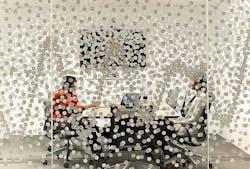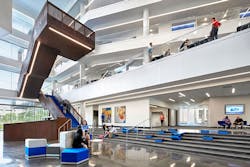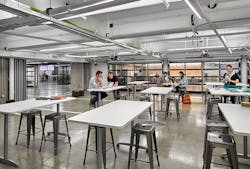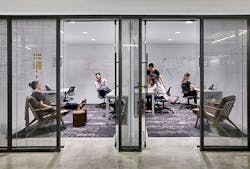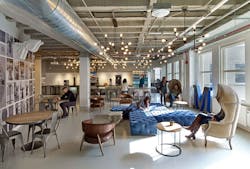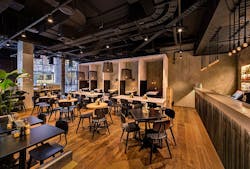Let’s get physical: Design possibilities for the digital classroom
Last year, we ran a blog series on Reimagining Learning in which our team defined six learning behaviors—acquire, experience, collaborate, and reflect, master, and convey—and identified how physical space can support them. As companies are increasingly looking for people who can do things like communicate clearly, solve complex challenges, lead teams and define strategic direction, a growing number of learners are turning to any resource where they can learn these skills quickly, effectively and in sync with their busy lives. Thus far these skills have been taught in-person, but today many online resources are successfully teaching them in an entirely digital environment.
As an example, Northwestern University is running a course series called Organizational Leadership via Coursera that equips leaders to “lead in an ever-changing business environment.” The curriculum centers on developing skills that are not only critical for leaders at all levels of organizations but for any professional growing in his or her career – skills like storytelling, communicating, vision definition, conflict resolution, persuasion, design thinking, ideation and team management.
Having recently completed the course series, I was impressed at how successfully it taught these skills utilizing an entirely digital interface. Yet my experience also prompted me to wonder what possibilities could emerge if we could insert the physical environment into this digital classroom. As a thought-starter, I’ll propose several ways in which this could happen, using some of our recent projects as examples.
Communicating a Pitch
One assignment asks learners to imagine themselves in the position of a Senior VP of a company. The task is to create a pitch – a two-minute elevator speech – to present a plan to the company leadership for funding and supporting the development of an innovation created by a team member. Coming up with a succinct, compelling story is challenging in itself, but what if learners also had to present their pitch? Offering a physical space in which learners could come together at a designated time to practice and critique each other’s pitches could dramatically supplement the exercise. Here are a couple of ways this might play out at Capitol Federal Hall, the School of Business at the University of Kansas:
At the same time, the digital screen in the building’s main atrium is intended to show current work happening throughout the school. This screen could be an ideal vehicle for displaying student pitches that were really successful or even those that weren’t as learning opportunities for others. Image © Gensler.
Hosting a Design Thinking Jam
Another course in the series on Design Innovation takes learners through a design thinking process of observation, ideation, synthesis, prototyping, and gathering user feedback. To further encourage collaborative brainstorming, the course could provide space in a local innovation lab for students to come together at designated times. Learners could sign up and indicate whether they expected to lead the session to develop their own idea or participate in helping others ideate theirs. This opportunity to engage in a session together would give learners a chance to practice facilitation—a skill that comes in handy in many situations at work, no matter the industry or task – and learn ways to optimize brainstorming. The Garage at Northwestern University offers spaces to engage in all of the phases of the design thinking process with the benefit of having other peers on hand for an impromptu design jam or critique:
Ideation space at the Garage: On hand are writable surfaces and digital screens on which to present ideas and organize concepts; elements like glazed walls and curtains provide connectivity across the entire space, allowing groups to simultaneously focus on their task but find inspiration in the work happening around them. Image © Gensler.
Create a Team Cohort
Many higher education programs structure learning curricula around student cohorts, but – although workplace settings require a great degree of teamwork – cohort learning opportunities are less common at work. This type of course series seems well-suited for a team that works together in the professional world to enroll, and it teaches skills that would likely have a dramatic positive impact on a team’s performance if collectively learned together. There are multiple places in the work environment in which a team could come together to discuss assignments, ideate, synthesize concepts, and give constructive feedback; at Motorola Mobility in the Merchandise Mart:
Faculty Fireside Chats
The involvement of Northwestern's world class faculty sets this course apart from others, but the current course structure limits their contributions to presenting content in the lecture videos. There were several topics - like conflict resolution and persuasion - for which I felt an in-depth, in-person discussion with that faculty member would augment the course material. One way to provide an opportunity to explore some of the course themes more deeply and connect learners with faculty would be to host monthly faculty fireside chats at venues around the city.
The above ideas are just a start, and we invite you to join the conversation with other ideas for integrating physical space into the digital classroom. As alternatives like personalized learning pathways and open source content have emerged as the new norm, the conversation is just getting started. So dream into what these evolutions could be with us, and send us your ideas!
